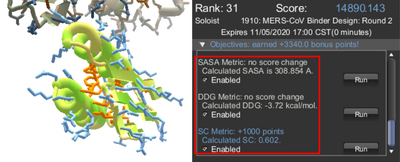
Binder metrics in the objectives area. The DDG, SASA, and shape complementarity metrics are available in this puzzle.
A metric is a type of objective. Metrics are similar to conditions, but there are important differences. Both conditions and metrics may change the score, offering bonuses or penalties.
One goal of metrics is to improve designs on binder puzzles.
Binder metrics include DDG, SASA, and shape complementarity. These metrics all evaluate the "interface" where a protein binder attaches to a different protein target.
Binder metrics were first described in a March 2020 Foldit blog post titled Analysis of Protein Binder Designs. At one point, these metrics could not be calculated in Foldit. Separate external tools plus access to player solutions were required.
Metrics appear in the objectives area of Foldit. For performance reasons, these metrics are treated differently than conditions, which also appear as objectives.
The blog post Introducing Foldit Metrics describes the metrics as of October 2020.
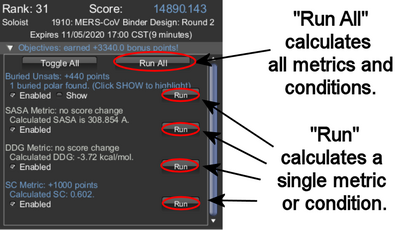
In the objectives area, "Run All" calculates all metrics. Each metric can also be calculated separately using the corresponding "Run" button.
The wiki article condition and metric control describes how metrics differ from conditions.
Unlike conditions, the bonuses for metrics may not be available immediately. Instead, metrics are being calculated "in the background". The bonuses for metrics appear once the calculations are complete.
Once calculated, the metrics are displayed in the objectives area. The metrics remain displayed until part of the protein changes, when the metric values are replaced by the message "calculating". The overall score is also "greyed out" while metrics are being calculated.
Recipes can access metrics through these functions:
Metrics are not integrated into the underlying Rosetta software that provides the scores in Foldit. So it's possible a binder design with good metrics will have a relatively poor Foldit score, and vice versa.
Individual metrics are described below.
DDG[]
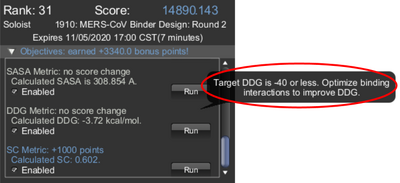
For DDG, a value of -40 kcal/mol is suggested. The lower the value, the better the fit between the binder and the target.
DDG measures the change in free energy when the binder is close to the target protein as opposed to when the target and the binder are free apart. A decrease in free energy when the binder is close to the target is desirable.
DDG is measured in kilocalories per mole, abbreviated as kcal/mol.
Hovering over the calculated DDG objective shows a suggested goal, which has been -40 kcal/mol in the early puzzles.
The displayed value of DDG uses the "E notation" version of scientific notation. A display value like "3.46e-10" means 3.46 times 10-10. This would be a very small positive value, where a much larger negative value is desirable.
See DDG for more detail.
SASA[]
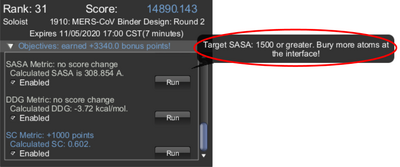
A target SASA of 1500 A2 is suggested. Unlike DDG, the higher the SASA, the better.
SASA is "solvent accessible surface area". As a binder metric, SASA refers to the surface area of the interface between the binder and the target. When the binder is close to the target, this area is actually inaccessible to the solvent.
The larger the SASA score, the better. SASA is measured in square Angstroms, or Å2.
Hovering over the calculated SASA objective shows a suggested goal, set at 1500 Å2 in the puzzles to date.
See SASA for more.
Shape complementarity[]
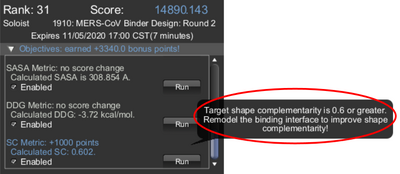
The suggested goal for shape complementarity is 0.6 or higher. A value of 1.0 indicates a perfect match, but may be hard to reach.
Like the DDG and SASA metrics, the shape complementarity binder metric looks at the interface between the binder and the target. As the names suggests, shape complementarity tries to determine how well the shape of the binder matches the shape of the target.
Unlike DDG and SASA, shape complementarity is a unitless value which can range from 0.0 to 1.0. The higher the shape complementarity value, the better.
A shape complementarity value of -1 is also possible, indicating the binder is too far from the target or the interface is too small for a meaningful calculation.
Hovering over the calculated shape complementarity shows a suggested target, which has been set to 0.6 in the initial puzzles.
See shape complementarity for more.